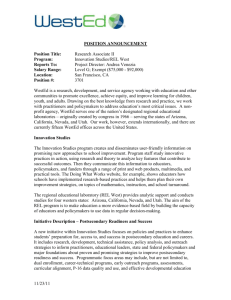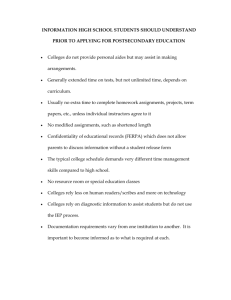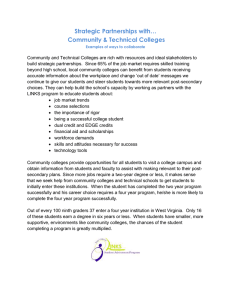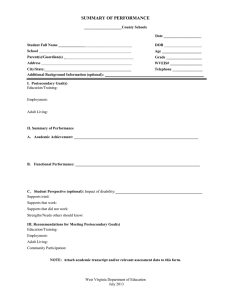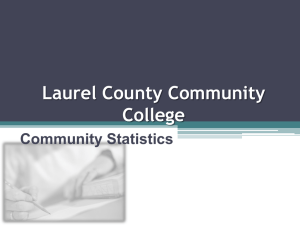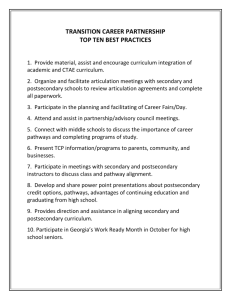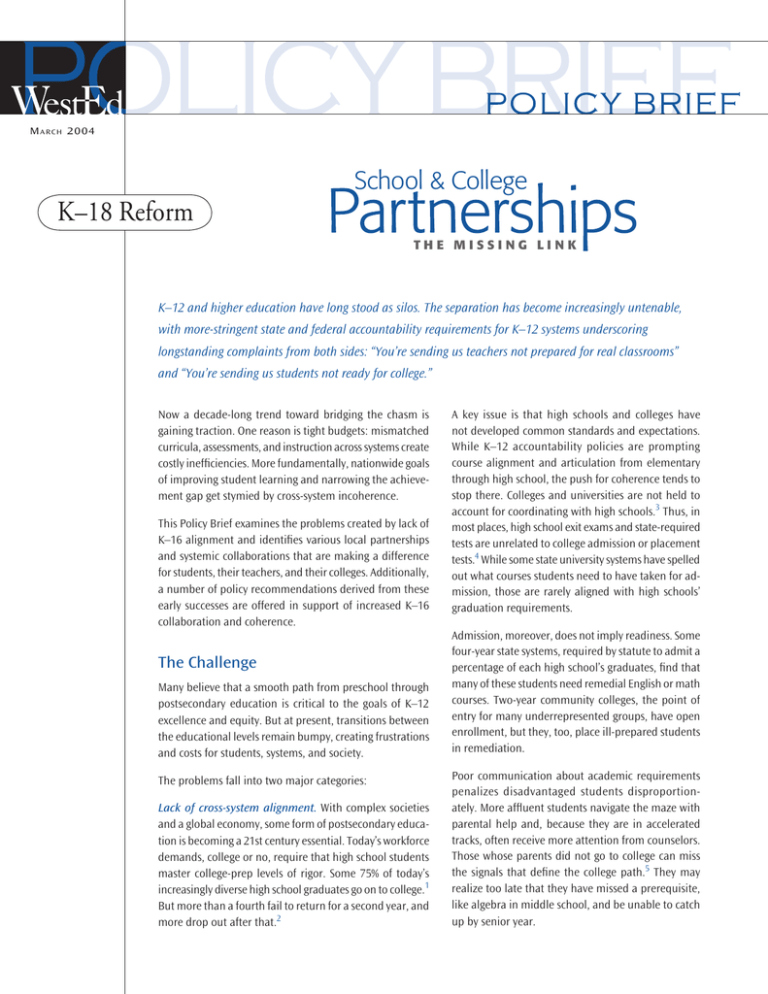
M A R C H 2004
School & College
K–18 Reform
THE MISSING LINK
K–12 and higher education have long stood as silos. The separation has become increasingly untenable,
with more-stringent state and federal accountability requirements for K–12 systems underscoring
longstanding complaints from both sides: “You’re sending us teachers not prepared for real classrooms”
and “You’re sending us students not ready for college.”
Now a decade-long trend toward bridging the chasm is
gaining traction. One reason is tight budgets: mismatched
curricula, assessments, and instruction across systems create
costly inefficiencies. More fundamentally, nationwide goals
of improving student learning and narrowing the achievement gap get stymied by cross-system incoherence.
This Policy Brief examines the problems created by lack of
K–16 alignment and identifies various local partnerships
and systemic collaborations that are making a difference
for students, their teachers, and their colleges. Additionally,
a number of policy recommendations derived from these
early successes are offered in support of increased K–16
collaboration and coherence.
The Challenge
Many believe that a smooth path from preschool through
postsecondary education is critical to the goals of K–12
excellence and equity. But at present, transitions between
the educational levels remain bumpy, creating frustrations
and costs for students, systems, and society.
The problems fall into two major categories:
Lack of cross-system alignment. With complex societies
and a global economy, some form of postsecondary education is becoming a 21st century essential. Today’s workforce
demands, college or no, require that high school students
master college-prep levels of rigor. Some 75% of today’s
increasingly diverse high school graduates go on to college.1
But more than a fourth fail to return for a second year, and
more drop out after that.2
A key issue is that high schools and colleges have
not developed common standards and expectations.
While K–12 accountability policies are prompting
course alignment and articulation from elementary
through high school, the push for coherence tends to
stop there. Colleges and universities are not held to
account for coordinating with high schools.3 Thus, in
most places, high school exit exams and state-required
tests are unrelated to college admission or placement
tests.4 While some state university systems have spelled
out what courses students need to have taken for admission, those are rarely aligned with high schools’
graduation requirements.
Admission, moreover, does not imply readiness. Some
four-year state systems, required by statute to admit a
percentage of each high school’s graduates, find that
many of these students need remedial English or math
courses. Two-year community colleges, the point of
entry for many underrepresented groups, have open
enrollment, but they, too, place ill-prepared students
in remediation.
Poor communication about academic requirements
penalizes disadvantaged students disproportionately. More affluent students navigate the maze with
parental help and, because they are in accelerated
tracks, often receive more attention from counselors.
Those whose parents did not go to college can miss
the signals that define the college path.5 They may
realize too late that they have missed a prerequisite,
like algebra in middle school, and be unable to catch
up by senior year.
Students admitted to college are often stunned to find that, despite
having passed high school exit exams and state tests, they have been
placed in college remediation, meaning it will take longer and cost
more to graduate. The college preparation they thought they got in
high school turned out to be less than what is needed.6 (Even students
who suspect that their high school courses lack rigor do not know
how to make up for it.7) Besides absorbing the cost of remediation
classes,8 colleges expend resources on numerous courses redundant
with those taught in high school. This is especially notable in math
since many students take no math in 12th grade and then need refresher courses in college.
Insufficient collaboration on teacher preparation. The federal No
Child Left Behind act requires a highly qualified teacher in every K–12
classroom. Here, system interdependency is especially clear.9 Teacher
recruitment and preparation, especially of minority candidates, calls
for joint K–12, community college,10 and university strategies. Expertise shared across faculties can improve teaching at all levels, better
ensuring all K–12 students a college-prep level of rigor — and a
culture of high expectations — by improving curricula, assessment,
and alignment. But a norm of institutional distance remains, and
many professors do not see K–12 as scholarly. Professors, as a result,
lack grounding in K–12 realities while K–12 teachers lack the connectedness they need to stay up to date on college admission and
placement policies.11
Ways to Integrate the Systems
The most obvious starting place for bridging systems is the high school
to college transition. Some key steps are being initiated by partnerships around the country:
» Students take college placement tests for diagnostic purposes
in middle school and early high school. This allows students to
see early and repeatedly where they need to focus their efforts for
college entry without remediation.12 Higher education regents in
Oklahoma offer such testing for 8th and 10th graders, mindful that
under-preparation starts in middle school.13
» Performance on high school exams relates to college admission
or placement decisions. Several states are exploring linking high
school exit exams to public college admission.14 Such approaches
can streamline the confusing mix of tests and help clarify college
expectations for K–12 students and educators.15 Oregon’s university
system is moving to base admissions on students’ demonstrated
mastery of knowledge and skills under the state’s K–12 standards
as evidenced by scores on state and national tests and high school
assignments.16 Such efforts create the often-lacking motivation for
students to do well on state tests. However, if states tie their tests
to minimum, rather than rigorous, standards, colleges will reject
such linking.
02
» Colleges share freshmen performance information with high
schools. High schools armed with data on how their graduates
fare in college can use the information to improve student preparation. Postsecondary schools in some 21 states now provide such
feedback, but how secondary schools use it is unclear.17 One recent
study found that high school staffs did not know how to use the
data, had no time to figure it out, and received no help.18
» Faculties cross systems. When postsecondary professors work
part-time in high schools and K–12 teachers also serve as teacher
education faculty, teamwork blossoms. In Texas’s highly successful
El Paso Collaborative, such teams set high standards and aligned
curriculum and assessment up and down the grades.19 Cross-faculty
teams in Long Beach, California, (see box) analyzed college English
and math placement exams and revamped the high school curriculum to ensure alignment with those exams (given diagnostically
to 11th and 12th graders).
Barriers
As the movement toward K–16 partnerships gains momentum, key
obstacles must be overcome:
» Lack of an organizational hub for K–16 policymaking and oversight. At the state level, separate legislative committees and funding
streams mitigate against K–16 policymaking and communication
on such issues as funding, data sharing, teacher development, and
matriculation.20 Local partnerships are numerous, but levers for
systemic collaboration are rare.21
» Little incentive for postsecondary education. Many universities
have “outreach” programs offering tutoring or mentoring to poor
and minority high schoolers. More unusual is a commitment that
requires changes in postsecondary education itself. In most states,
no market incentive exists; colleges have more than enough applicants. And motivational levers such as K–16 accountability systems or cross-sector funding mechanisms are generally absent.
Governors and legislatures focus on K–12 but have considered
higher education untouchable.22 Partly, the incentive problem
is internal: Higher education faculty are not rewarded for K–12
work. Notable exceptions include the University of Texas, El Paso,
where President Diana Natalicio says, “We prepare teachers for the
public schools, and we admit their students. So it’s our problem
just as much as theirs.”23
» Lack of funding. Separate funding structures not only create disincentives to partner, but often place the systems in competition
for limited dollars.
WestEd
K–18 R E F O R M
Policy Considerations
To foster cross-segment partnering, state, local, and institutional policymakers
are focusing on one key task: changing incentives.
STATES
No state has a fully integrated preschool-through-university system.24 But a
number have set up statutory or voluntary governance structures wherein leaders across systems assume joint responsibility for K–16 outcomes. Experience
supports certain priorities, including the following:
» Plan as a system. A K–16 plan provides a roadmap for crafting silo-bridging
policies (e.g., funding allocations that reward cross-system teacher preparation programs). In California, a joint legislative committee has drafted
a master plan for pre-K through college; the state’s landmark 30-year-old
master plan for postsecondary education would be folded in. Using a strategy
pioneered in Georgia, some 22 states have joined a nationwide K–16 project
wherein leaders from higher education, K–12, business, and the community take responsibility for coordinating reforms across systems.25 State-level
councils support local councils to enact the plans. In some states, business
launches such efforts, as with Arizona’s P-20 initiative.
» Develop K–16 data systems. To get vital information about how their students fare in each segment, institutions need — and states generally lack
— a cross-segment achievement data system. Data should include common student identifiers across segments and be available quickly so that
high schools can use the information. Colleges and high schools also need
resources and incentives not just to share data, but to learn together how
to use the information to improve policies and practices.26
» Make no-stakes diagnostic testing part of the state testing program. Starting in middle school, such testing would help communicate college-going
expectations, define what college readiness means, and guide student and
teacher efforts.
LOCAL AND INSTITUTIONAL
Across the country, local and regional partnerships are leading the way. Their
actions include the following policies: 27
» Make CEOs of the local school district, university, and community college
jointly accountable. Shared responsibility for ensuring cross-segment alignment (e.g., on decisions such as changes in transfer policies) is critical.
» Form cross-segment teacher preparation committees. Teacher preparation
programs should be overseen by a committee that includes faculty from arts
and science (not just teacher education), community colleges, and K–12
schools.
» Include K–14 and community voices in university admissions and placement planning. Such participation opens cross-sector communication and
leads to better-informed decisions.
CALIFORNIA STATE UNIVERSITY:
MORE THAN OUTREACH
The California State University system must accept the top
third of its state’s high school graduates; more than half
require remediation. To address this crisis, CSU negotiated
with K–12 policymakers to enhance the 11th grade statewide
test, then adopted that test as its own placement exam, becoming the first state system to use a state test for placement
purposes.28 The collaborative move clarifies expectations,
saves testing time and costs, and motivates students with
unacceptable scores to use the often-wasted 12th grade year
for catch up. Individual CSU campuses, meanwhile, have
their own K–16 partnerships, including:
Seamless education in Long Beach.29 This 10-year partnership of CSU Long Beach, Long Beach Unified School District,
and Long Beach City College focuses partly on alignment,
as described above. Also, its emphasis on coherent exit and
entry expectations and teacher preparation and development has resulted in such innovations as an interlinked
program of teacher education between the university and
the community college, with Long Beach Unified providing
clinical experience. The curriculum is co-developed by the
faculties, extensive co-teaching occurs, and the common
structure and sequence ensure candidates a smooth transition from community college to university.30 One upshot is
that more credentialed teachers from the university now
work in Long Beach Unified, where the number of emergency-credentialed teachers has dropped. And evidence
exists of improved student achievement, the ultimate goal:
the number of 5th graders reading at grade level rose from
6.7 percent in 1999 to 53.3 percent in 2002.31
College guarantee in San Diego.32 Launched in 2001, a
“Compact for Success” between San Diego State University (SDSU) and the Sweetwater Union High School District
(grades 7–12) guarantees that any 7th grader who keeps a B
average through 12th grade and completes all CSU prep requirements without need for remediation will be admitted
to SDSU. Qualifying students in need will get a scholarship
from a community-generated fund — important for the
many low-income, Latino students in this border district.
Students begin taking SDSU placement exams diagnostically in 10th grade. If they score well enough, SDSU waives
its SAT requirement. The partners work jointly to promote
awareness of the compact among students and families,
sponsor campus experiences, ensure the requisite coursework and rigor across all district high schools, and ensure
that those admitted to SDSU persevere and graduate. The
district reports that B averages are up, and the compact
has prompted families to move into the district.
03
K–18 Reform
POLICY BRIEF
Endnotes
Excellence in research, development, & service
The states of Indiana, Kentucky, Nevada, Texas, and
Massachusetts participate in the American Diploma
Project, which explores using standards-based
achievement data in college admissions and hiring.
Information available at http://www.americandiploma
project.org
15
Kazis, R., Pennington, H., Conklin, K. (2003). Ready
for tomorrow: Helping all students achieve secondary
and postsecondary success. Washington, DC: National
Governors Association. Available at http://www.nga.org
16
Proficiency-Based Admission Standards System (PASS)
Web site: http://www.ous.edu/pass/about/policy_
report.html
17
Ibid.
18
Venezia, et al. Betraying.
19
Van de Water, G., & Rainwater, T. (2001). What is p–16
education? Denver, CO: Education Commission of the
States. Available at http://www.ecs.org
20
Kirst & Venezia. Bridging.
21
Venezia. Student-centered p–16 accountability.
22
Kirst & Venezia. Bridging.
23
Quoted in the Chronicle of Higher Education, as cited
in Kleiman, 2001, p. 15.
24
State Higher Education Executive Officers. Student
Success.
25
“State K–16 Networks” is a project of the Education
Trust and the National Association of System Heads.
Information available at http://www.nashonline.org
26
Kazis, et al.
27
California Alliance of PreK–18 Partnerships. (in press).
Effective education partnerships: Policy and practice.
Long Beach, CA: Author.
28
Kirst. Using a k–12 assessment.
29
This year the Broad Foundation named LBUSD as the
nation’s best urban school system.
30
McRobbie, J. (2001, May/June). Seamless schooling.
Leadership. Sacramento, CA: Association of
California School Administrators. Available at http:
//www.WestEd.org/pub/docs/174
31
Reported in California Alliance of PreK–18
Partnerships' Effective education partnerships.
According to Long Beach Unified School District (L.
Winters, personal communication, December 4, 2003),
proficiency was measured by a district-developed
benchmark that correlates to the state’s standards test.
32
WestEd Policy program. (2003). [Study of school
districts on U.S.-Mexico border]. Unpublished raw data.
14
Kleiman, N.S. (2001, June). Building a highway to
higher ed: How collaborative efforts are changing
education in America. New York: Center for an Urban
Future. Available at http://www.nycfuture.org
2
Mortenson, T. (2003). Freshman to sophomore
persistence rates by institutional control, level, and
academic selectivity, 1983-2003. Oskaloosa, IA:
Postsecondary Economic Opportunity.
3
Venezia, A. (2002). A student-centered p–16
accountability model: Encouraging high standards,
equitable educational opportunities and outcomes,
and flexibility within a seamless system of education.
Denver, CO: Education Commission of the States.
Available at http://www.ecs.org/clearinghouse/40/04/
4004.htm
4
Venezia, A., Kirst, M.W., & Antonio, A.L. (2003).
Betraying the college dream: How disconnected k–12
and postsecondary education systems undermine
student aspirations. Stanford, CA: Stanford Institute
for Higher Education Research. Available at
http://www.stanford.edu/group/bridgeproject/
publications.html
5
Kirst, M., & Venezia, A. (2002, April). Bridging
the great divide between secondary schools and
postsecondary education. San Jose, CA: National Center
for Public Policy and Higher Education.
6
See Conley, D. (2003). Mixed messages: What state
high school tests communicate about student readiness
for college. Eugene, OR: Center for Educational Policy
Research, University of Oregon.
7
Venezia, et al. Betraying.
8
Kirst, M.W. (in press). Using a k–12 assessment for
college placement. Berkeley, CA: Policy Analysis for
California Education.
9
State Higher Education Executive Officers. (2003).
Student success: Statewide p–16 systems. Denver,
CO: Author. Available at http://www.sheeo.org/k16/
P16.pdf
10
See also Lee-Bayha, J., & Villegas, M. (2003,
October). The changing role of community colleges
[Policy Brief]. San Francisco: WestEd. Available at
http://www.WestEd.org/pub/docs/296
11
Kirst, M., & Venezia, A. (in press). Improving k–16
transition for broad access to postsecondary education.
Boston, MA: Jobs for the Future.
12
Kirst & Venezia. Bridging.
13
Olson, L. (2001, May 9). K–12 and college
expectations often fail to mesh. Education Week, p. 1.
1
®
730 Harrison Street • San Francisco • California • 94107-1242
Address service requested
This brief, authored by Joan McRobbie, is
issued by the WestEd Center on Policy (director,
Paul Koehler). For more information about
WestEd’s policy work, call 415.615.3160 or visit
www.WestEd.org/policy.
WestEd, a nonprofit research, development, and
service agency, works with education and other
communities to promote excellence, achieve
equity, and improve learning for children, youth,
and adults. While WestEd serves the states of
Arizona, California, Nevada, and Utah as one of
the nation's Regional Educational Laboratories,
our agency’s work extends throughout the United
States and abroad. It has 17 offices nationwide,
from Washington and Boston to Arizona, Southern
California, and its headquarters in San Francisco.
For more information about WestEd, visit our Web
site at WestEd.org, call 415.565.3000 or, toll-free,
(877) 4-WestEd, or write: WestEd, 730 Harrison
Street, San Francisco, CA 94107-1242.
This report was produced in whole or in part with funds
from the Institute of Education Sciences, U.S. Department
of Education, under contract #ED-01-CO-0012. Its contents
do not necessarily reflect the views or policies of the
Department of Education.
© 2004 WestEd. All rights reserved. Permission to reproduce,
with WestEd copyright notice included, is hereby granted.
Nonprofit
U.S. Postage
PAID
Los Alamitos, CA
90720
Permit No. 87

